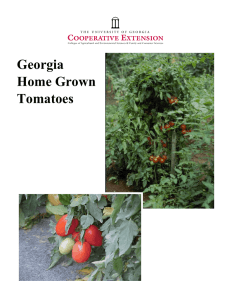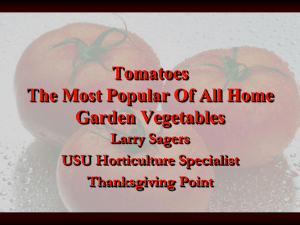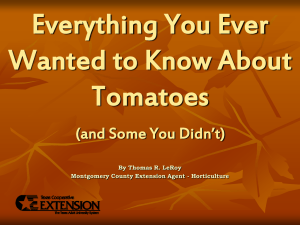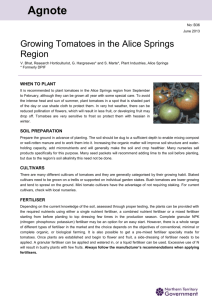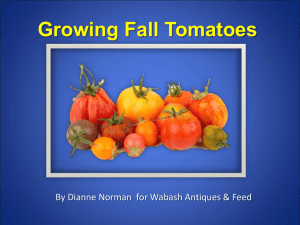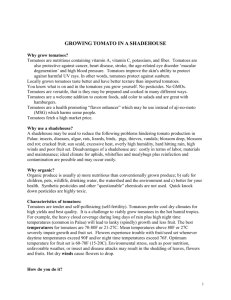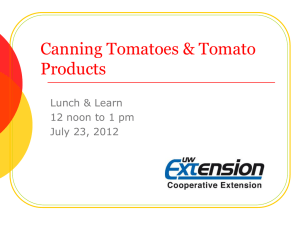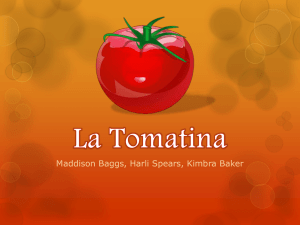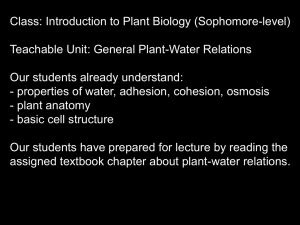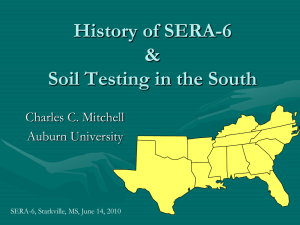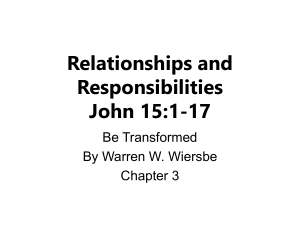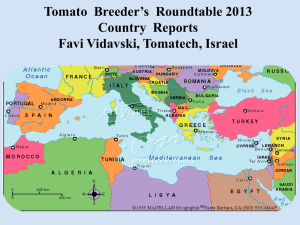How to Grow Great Tomatoes - University of Maryland Extension
advertisement
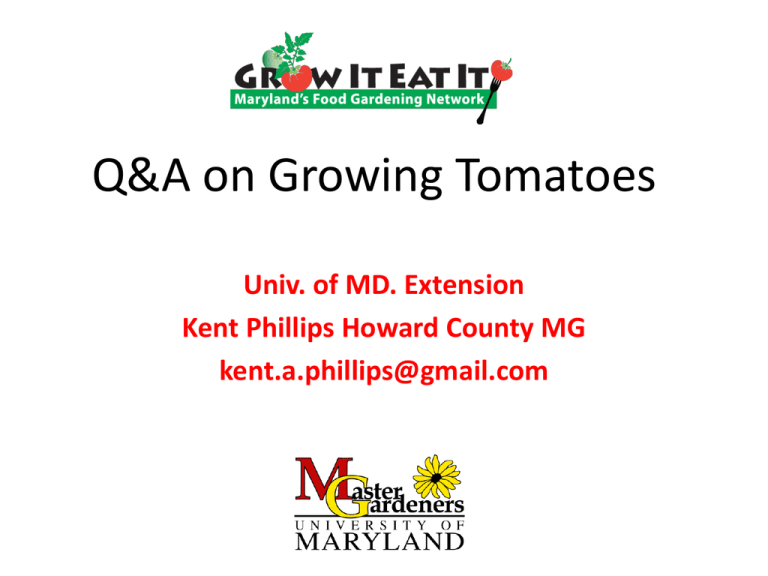
Q&A on Growing Tomatoes Univ. of MD. Extension Kent Phillips Howard County MG kent.a.phillips@gmail.com 2 Questions & Answers about Growing Tomatoes Q: What are simple tips for growing tomatoes for home use? • Do a soil test and follow recommendations • Choose sunny location, min. 8 to10 hrs. more is better • Choose varieties meeting your needs • Consider spacing & staking/caging • Don’t over-fertilize, consider slow release organic eg. Soybean meal • Insure 1-inch water per week (2-4 gallons per plant depending on size) Q: How do I choose good plants? • Look for short, stocky plants with dark-green leaves • Avoid plants that evidence disease (yellow leaves) or damage • Check label for resistance to diseases & pests (VFN…) and whether variety is determinate or indeterminate • Shop when new plants have arrived, often just before the weekend Q: What do “determinate” and “indeterminate” mean? • Determinate (aka “short”) varieties grow to the pre-determined height of the cultivar. They tend to produce fruit over a shorter time period and then die. They are great for people that process/can or freeze their fruit. Do NOT prune determinate varieties. • Indeterminate (aka “tall”) varieties produce fruit throughout the season, until frost kills the plant. Fruit set in early September will normally ripen before frost. Q: What do the abbreviations after variety names mean? Celebrity Hybrid VFFNTASt Resistance to V = Verticillium Wilt F = Fusarium Wilt FF = Races 1 & 2 FFF = Races 1, 2, & 3 N = Nematodes T = Tobacco Mosaic Virus A = Alternaria Stem Canker St = Stemphylium Gray Leaf Spot TSWV = Tomato Spotted Wilt Virus Code list from Totally Tomatoes 2013 catalog, p. 11 Q: Should I plant only heirlooms or only hybrids? A: Planting both can be insurance against disease or pest problems. Heirlooms usually don’t have any disease resistance. Sharon G.: “A great crop of reasonably tasty hybrids is better than a small, or no, crop of exceptionally tasty heirlooms.” Q: Should I fertilize my plants as they grow? • Depends on your soil. If you have good soil with lots of organic matter worked into it, you probably won’t need additional nitrogen. If you haven’t improved your soil, you may need additional nitrogen. • Too much nitrogen: One of the two major reasons of “too many vines, too few tomatoes.” Other reason: Too little direct sunlight. May contribute to blossom-end rot. Q: Do specialty fertilizers, such as “Tomatoes Alive,” do any good? • The simple answer is that you can get the same results with cheap 10-10-10 or an organic fertilizer and a bag of lime. “Tomatoes Alive” price: $34.95 for 7 lbs, which “feeds 49 plants.” • 10-10-10 costs $16.48, and 40 lbs. of pulverized lime costs $4.77, for total of $21.25. This would take care of over 500 plants. • Of course, you plants wouldn’t know the difference. Q: When should I transplant? A: When soil temperature reaches 55 to 60 degrees • Here, usually mid-May to 1st week of June • Use of plastic mulch will warm soil • If planted early, plants may grow slowly & be subject to insect & disease attacks • Early fruit will have blossom end rot (BER) • But choice plant varieties may not be available then at retailers, so buy & hold or start your own seed 5 week prior to plant out date. More transplanting tips … • Cloudy, wind-free day – or late afternoon • Dig holes in improved soil & mix in an once of 10-10-10 fertilizer, a handful of lime, and water in with transplant solution • Remove leaves except top 2-3 inches • If plants are leggy, bend plants in an L, set in a trench with two sets of leaves showing above the soil line. Protect from harsh weather with row cover. Q: Should I stake, cage, or trellis my plants or let them sprawl? A: Rationale for staking: Maximizes production from limited space; limits diseases and critter access; gives better access to fruit; old back doesn’t need to bend as often. Be sure to pinch suckers. A. Kent P.: “If you let your tomato plants sprawl, make sure you have some sort of dry mulch under them to keep the fruit from rotting.” Stake them* … Aylene G. Barbara W. *Indeterminate varieties may require more support Cage them … Ron N. Bob N. Trellis them … Pat G. & her Costoluto Genovese Q: How can I make cages out of heavyduty reinforcement mesh? A: Detailed online how-to article with photo illustrations: http://kgi.org/building-tomato-cages Q: Why and how should I prune my plants? A: “Suckers are shoots that arise from axils, the angle where a plant stem and leaf branch meet. These shoots will eventually produce flowers and fruit. Prune lower suckers out up to about 12 to 18 inches above the soil line. Caged or prostrate tomatoes need not be pruned. Produces maximum fruit. Pruning, p. 2 A: “Prune staked tomatoes to one to three main stems (plant spacing can be reduced in these situations). Remove all other suckers weekly. It is especially important to remove suckers that emerge from the plant base. Pinch shoots off with your fingers”—from “Master Gardener Handbook,” Chapter 17, Vegetables, p. 436. Pruning will hasten ripening. Pruning, p. 3 A: Also prune to control indeterminate/tall vines and to remove spent/dead stems/leaves HGIC video about tomatoes and pruning: https://extension.umd.edu/growit Click on “Growing Vegetables” and “Tomatoes” Q: How can I keep critters from eating my tomatoes? A: “Fence them in to control most critters. Squirrels can be especially difficult to control. If birds are a problem, nylon netting can be draped over plants to protect them. Various visual or sound ‘frightening’ techniques, such as loud noises, lights, and bright reflective objects, can also be very effective. Animals can become accustomed to them over time.... Critters (p. 2) “University of Maryland Master Gardener Handbook” (2012 ed.),” Chapter 28, Wildlife, p. 585 Chapter 28 covers other “nuisance animals,” from pigeons & woodpeckers through deer, rabbits, & squirrels, to groundhogs & snakes HGIC 1-800-342-2507 9 am – 1 pm Stink-bug damage to Virginia Sweets tomatoes Q: How can I keep stink bugs from destroying my tomatoes? A: University of Maryland Extension research reports: BMSB activity increases when fruit begins to ripen. Bugs may move into patch during day. Damage ranged to 48%. Pesticide test results. “Stop BMSB” cooperative site: http://www.stopbmsb.org Q: Stink bugs, p. 2 • Grow prostrate tomatoes. Stink bugs prefer high places • Hand-pick stink bugs • Combination of insecticidal soap, pyrethrum and Surround may be effective • Plant resistant varieties (Juliet & other smallfruited?), and • Pick fruit at “breaker” stage. What is picking at “breaker stage”? http://groweat.blogspot.com/2011/07/tomato-patch-learning-by-pickingat.html#axzz2JymSTQHi Posting includes link to original Kansas State University document Q: What are the spots on the lower leaves of my tomatoes and what should I do? • Research at HG 56, “IPM Series: Tomatoes” https://extension.umd.edu/hgic/resourcelibrary/home-and-garden-information-centerpublications • If it’s Early Blight, a fungal disease: select resistant varieties; remove all debris at end of season; increase spacing of plants; prune lower suckers/leaves; mulch; use a fungicide. Q How can I recognize tomato diseases, such as Late Blight? If my plants get such diseases, is the situation hopeless and I should destroy them? • Best source: “IPM Series: Tomatoes,” HG 56 and/or call Home & Garden Information Center. • Late Blight may be hopeless, but many other diseases aren’t. Identify the problem and then do what needs to be done. Information about diseases: IPM Series: Tomatoes (HG 56) Cover Page 6 Q: How do I find resistant varieties? • Internet search: “early blight resistant tomato varieties” • At http://vegvariety.cce.cornell.edu/main/myVeggies.php type “Early Blight” in Find, choose “In Description,” and then choose “Tomatoes” in “Crop.” • Result: Mountain Magic Hybrid, Juliet Hybrid, Legend OP, Matina heirloom, JTO-99197 Hybrid, Plum Regal Hybrid Q: My tomato plants died after yielding fruit—what happened? A: Plants may have been determinate variety and completed life cycle A: Disease may have caused die-back Q: What are the black spots on the bottom of my tomatoes, and what can I do to cure them? Blossom-End Rot is caused by calcium or water deficiency in soil Blossom-End Rot, p. 2 • Establish pH of 6.3 to 6.8 & calcium as per soil test* • Generally this early-season problem “naturally goes away” later in season • Add tablespoon of pulverized lime to planting hole; • Mulch to conserve moisture • Don’t over-fertilize • Drip irrigate deeply 1 to 4 gallons/plant per week • Remove affected fruit as soon as possible; and • Research proposed “cures.” *Test your garden soil every 3 to 5 years. Call or email the Home & Garden Information Center, and they will tell you how to do it and where to get your soil analyzed. Q: Does Epsom salt stop blossom-end rot? Popular Internet site: “Because blossom- end rot is a symptom of a calcium deficiency in the plant, Epsom salts, which supply calcium, can be part of the solution.” Book: “Adding Epsom salts to the soil before you plant will prevent blossom-end rot.” Q: Epsom salt (p. 2) A: Jon Traunfeld: “This is one of the big gardening myths. There is no calcium in Epsom salts. It’s magnesium sulfate. If anything, the Mg cations could compete with Ca cations for uptake by plant roots making blossom-end rot even worse…. Tomato varieties recommended by University of Maryland Extension TOMATOES (* = hybrid variety) Red: Better Boy*, Big Beef*, Big Boy*, Bucks County, Celebrity*, Delicious, Early Girl*, First Prize, Fourth of July, Jet Star*, Mortgage Lifter, Park’s Whopper*, Paul Robeson, Red Pear, Rutgers, Stupice, Supersonic*, Supersteak, Tomosa Pink/purple: Brandywine, Cherokee Purple, German Johnson, Giant Belgian, Pruden’s Purple Yellow: Banana Legs, Golden Boy, Green Zebra, Kellogg’s Breakfast, Lemon Boy, Sungold, Yellow Pear Publication HG 70 UME/HGIC recommendations, p. 2 Bi- or tri-colored: Big Rainbow, Georgia Steak, Mammoth German Gold, Pineapple, Striped German Paste: Amish Paste, Roma, San Marzano, San Remo, Super Italian, Viva Italia* Cherry: Gardener’s Delight, Sweet Chelsea, Sun Cherry, Sungold, Sweet 100*, Sweet Cherry, Sweet Million* Grape: Golden Sweet*, Juliet*, Red Candy, Santa*, Solid Gold, Smarty* HGIC recommendations for containers • • • • • • • Celebrity Hybrid (VFFNTASt) (3-4’ tall) Patio Hybrid (FASt) (24” tall) Pixie Hybrid (Burpee discontinued) Sweet Chelsea Hybrid (VFNT) (Indeterminate) Tiny Tim (18” tall) Totem Hybrid (10-12” tall) Tumbling Tom (red or yellow) (cascades 18”) Rutgers University 5-year test of 145 heirloom varieties • Large: Cherokee Purple, Mortgage Lifter, Hawaiian Pineapple, Pruden’s Purple • Medium: Eva Purple Ball, Arkansas Traveler, Box Car Willie, Lemon Boy, Costoluto Genovese, Ramapo, Brandywine Red, Green Zebra • Cherry: Snow White, Isis Candy, Yellow Pear Carroll County Master Gardener heirloom favorites (2011 survey) • • • • • • • • • Aunt Ruby’s German Green Pink Brandywine Yellow Pear Pineapple Black Krim Cherokee Purple Green Zebra Amish Paste Rutgers Pink Brandywine (Sudduth’s Strain) Master Gardener favorites (2013) Carroll & Howard counties survey 1. Brandywine 2. Sungold Hybrid 3. Black Krim 4. Big Boy, Green Zebra, Mr. Stripey, Roma, Sweet 100 Hybrid (tie) Sungold Master Gardener favorites (2013) Carroll & Howard counties survey 5. Big Mama, Beefmaster, Black Plum, Campari, Celebrity, Cherokee Purple, Delicious, Early Girl, Garden Peach, Lemon Boy, Marglobe, Pineapple, Rutgers, Yellow Jubilee, Yellow Perfection (tie) Kent Phillips with Big Mamas Where did you buy tomato seeds? (2013 survey) 1. Totally Tomatoes 2. Johnny’s Selected Seeds, R.H. Shumway’s, “saved seeds” (tie) Where did you buy seeds? (cont.) 1 each: Baker Creek, Burpee, Cook’s Garden, Fedco, “freezer,” Heritage Harvest, Home Depot, Hudson Valley Seed Library, Jung, Landreth, Meyer, Monticello, Park, Seeds of Change, Territorial, & Victory Where did you buy transplants? 1. Home Depot 2. Clark’s Ace Hardware, Lowe’s, Southern States (tie) 3. Frank’s Produce Market, “gift” (tie) Where did you buy transplants? (cont.) 1 each: Annual Training Day, Behnke, Country Nursery, DeBaggio’s Herb Farm, Sharp’s at Waterford Farm What is your favorite seed catalog? 1. Burpee (38 tomato varieties), Totally Tomatoes (294) (tie) 3. R.H. Shumway’s (43) 4. Baker Creek Heirloom, Jung, Landreth, Pepperjoe, Seeds of Change, Vermont Bean, & Victory (tie) Q: What’s a safe source about canning tomatoes safely? National Center for Home Food Preservation http://nchfp.uga.edu/publications/publications_usda.html Free online factsheets, including “Canning Tomatoes &Tomato Products” Recommended book, “So Easy to Preserve,” covers canning, freezing, drying, 375 pages, 185 tested recipes, $18. New demonstration DVDs based on book, $39.95 Canning varieties often mentioned on Internet • • • • • Roma (D*) Rutgers (D) Amish Paste (I*) Opalka (I) Brandywine (I) *D = Determinate/short I = Indeterminate/tall Resource: Home & Garden Information Center www.extension.umd.edu/hgic 1-800-342-2507 (8 am to 1 pm, Monday thru Friday) HGIC/GIEI Internet resources • Grow It Eat It web site: http://extension.umd.edu/growit Free publications, videos, & other resources • Grow It Eat It blog: – www.extension.umd.edu/growit and click on “Grow it Eat It” blog on right side of page • Grow It Eat It on Facebook: Search: “Grow It Eat It” Resource: University of Maryland Master Gardener Handbook Chapter 17, Vegetables Library: R Md. 635M May your harvest this season be as good as this… Tomatoes by Kent Phillips, MG This program was brought to you by Maryland Master Garden Program Howard County University of Maryland Extension
